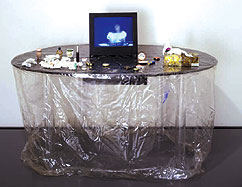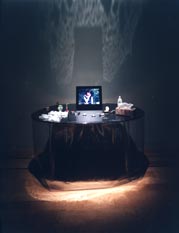 |
Photo courtesy: The Newark Museum, New Jersey,
USA |
 |
| Photo: TAKAYAMA Kozo |
|
|
Robert Whitman was one of the first to produce important mixed media performances and happenings from the late 1950s to the early 1960s. The projected images he used from his early period eventually became Super-8mm film projections in classic performance, like his American Moon (1960). This piece is one of four in the "Film Sculpture" group (1962-64), which includes Window (1963), Shower, and Sink (both from 1964). Whitman took everyday gestures as his theme and worked to create a "visual poetry" that would fuse film images with related physical devices. In this sense, some of his work was close to the sculptures of George Segal.
The Dressing Table is one of the first works from his early period to transform an image projected on a film screen into a medium for sculpture. Watching the performer apply her makeup, the viewer is pulled voyeuristically into the theatrical structure of the work and notices that the messy dressing table is the same as the one being used in the film. (*1)
When this work was exhibited with the other three "Film Sculpture" works in 1968 at the Chicago Museum of Contemporary Art, Whitman made a record to accompany the works. He recorded four songs that he himself sang, one for each piece, and distorted the sound using a device invented by Bell Labs. (*2)
When he made these works, Whitman was interested in time and optics and thought he could create "magic," "illusion," and "mystery" using old film images and simple technology. "The thing about theatre that most interests me is that it takes time. Time for me is something material. [...] It can describe other natural events. [...] Description is done in terms of experience."(*3) Whitman considered his work as environments. And in his theater works he carefully constructed environments that would envelop both the performers and the spectators. They were theatrical environments and situations in which people could participate freely if they wanted. In this sense, they were on the same trajectory as the happenings he organized in 1960 to 1961. Most important was that the spectators themselves took responsibility for their own experience, an attitude that also resonated with Whitman's guidelines for treating the spectators lining up for the Pepsi Pavilion at "Expo'70 Osaka." "Do nothing about crowd control.... [T]reat people as human beings, let them make up their own minds! Put them back on their own responsibility. If they want to wait in lines, let them wait in lines, but make it as interesting as possible while they are waiting."(*4) Whitman thought of the "work (as an environment)" as a mysterious place where visitors wandered around, yet would eventually find their way like in Alice in Wonderland. [KAMIKANDA Kei]
*1 - - See the home page for the Newark Museum, New Jersey.
*2 - - Chrissie Iles, Into the Light: The Projected Image in American Art, 1964-1977 (New York: Whitney Museum of American Art, 2001), 86.
*3 - - Robert Whitman, "The Night Time Sky: A Statement," rewritten from a recorded interview by Michael Kirby and Richard Schechner, eds., Tulane Drama Review, XX, (winter 1965): 134; cited in Norma Loewen, Experiments in Art and Technology: A Descriptive History of the Organization (Ph.D. diss., New York University, 1975), 34.
*4 - - Nino Lindgren, "Into the Collaboration," in Pavilion by Experiments in Art and Technology, eds. Billy Kl er, Julie Martin, and Barbara Rose (New York: E. P. Dutton & Co., Inc., 1972), 14. er, Julie Martin, and Barbara Rose (New York: E. P. Dutton & Co., Inc., 1972), 14.
|
